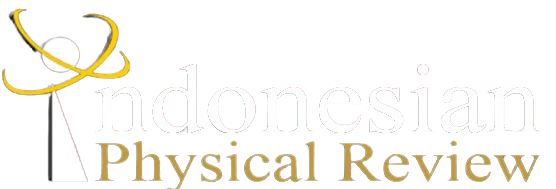ELECTROMAGNETIC WAVE EQUATION ON DIFFERENTIAL FORM REPRESENTATION
DOI:
10.29303/ipr.v1i1.12Downloads
Abstract
One of the indispensable part of the theoretical physics interest is geometry differential. This one interest of physical area has been developed such as in electromagnetism. Maxwell's equations have been generalized in two covariant forms in differential form representation. A beautiful calculus vector in this representation, such as exterior derivative and Hodge star operator, lead this study. Electromagnetic wave equation has been expressed in differential form representation using Laplace-de Rham operator. Explicitly, wave equation shows the same form in Minkowski space-time like vector representation. This study is able to introduce us to learn application of  differential form in physics.References
Griffith, D. J. (1999). Intoduction to Electrodynamics. New Jersey : Prentice-Hall.
Jackson, J. D. (1999). Classical Electrodynamics, edisi 3. USA : John Wiley & Son, Inc.
Deschamps, G. A. (1981). Electromagnetics and Differential Forms. Proceedings of the IEEE, 69, 6, 676-696.
Warnick, F., Selfridge, R. H., & Arnold, D. V. (1997). Teaching Electromagnetic Field Theory Using Differential Form. IEEE Transactions on Education, 40, 1, 53-68.
Solomon Akaraka Owerre. (2010). Maxwell’s Equations in terms of Differential Forms. African Institute for Mathematical Sciences (AIMS).
Hossine, Z. and Ali, S. (2017). Homogeneous and inhomogeneous maxwell’s Equations in terms of hodge star operator. GANIT J. Bangladesh Math. Soc. 37, 15-27
Nakahara, M. (2003). Geometry, Topology and Physics 2 ed. London: Institut of Physics Publishing
Warnick, K., and Russer, P. (2006). Two, Three and Four-Dimensional Electromagnetics Using Differential Forms. Turk J Elec Engin, 14, 1, 153-172.
License
Copyright (c) 2018 Indonesian Physical Review

This work is licensed under a Creative Commons Attribution-NonCommercial-ShareAlike 4.0 International License.
Authors who publish with Indonesian Physical Review Journal, agree to the following terms:
- Authors retain copyright and grant the journal right of first publication with the work simultaneously licensed under a Creative Commons Attribution-ShareAlike 4.0 International Licence (CC BY SA-4.0). This license allows authors to use all articles, data sets, graphics, and appendices in data mining applications, search engines, web sites, blogs, and other platforms by providing an appropriate reference. The journal allows the author(s) to hold the copyright without restrictions and will retain publishing rights without restrictions.
- Authors are able to enter into separate, additional contractual arrangements for the non-exclusive distribution of the journal's published version of the work (e.g., post it to an institutional repository or publish it in a book), with an acknowledgment of its initial publication in Indonesian Physical Review Journal.
- Authors are permitted and encouraged to post their work online (e.g., in institutional repositories or on their website) prior to and during the submission process, as it can lead to productive exchanges, as well as earlier and greater citation of published work (See The Effect of Open Access).





